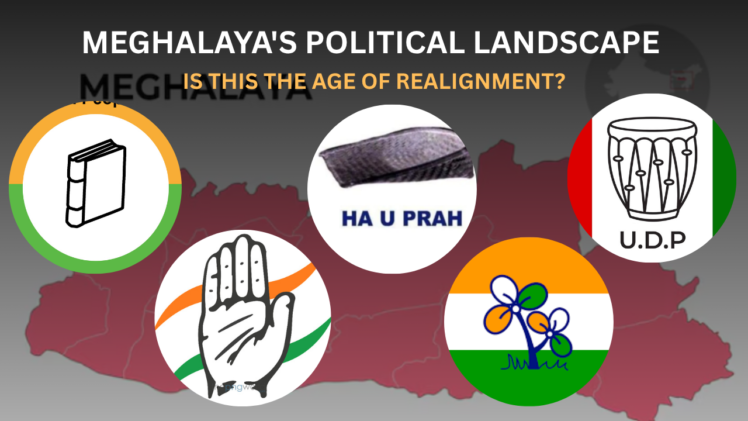
SHILLONG:
2025 and its many firsts in Meghalaya politics – in a single stroke, the Indian National Congress—once the dominant force that shaped the state’s destiny—has vanished from the Assembly, while the National People’s Party (NPP) has stormed into the record books with an absolute majority, surpassing the legendary All Party Hill Leaders Conference (APHLC) 32 seat- record of 1972.
At the centre of this political earthquake is Mylliem MLA Ronnie V. Lyngdoh—a man who became the final actor in a grand political theatre, ensuring both the fall and the rise of empires.
Ronnie V Lyngdoh – the man who rolled the last dice on the Chessboard of Power
Ronnie V. Lyngdoh, the last remaining Indian National Congress MLA in the Meghalaya Legislative Assembly, officially called it quits on July 30, 2025. With his move, Congress now has zero representation in the 60‑member assembly, while the NPP’s strength has grown to about 33 MLAs.
Lyngdoh officially joined the National People’s Party on August 5 and was welcomed into the party’s fold by Chief Minister Conrad K. Sangma, who is also the national president of the NPP.
A ‘triumphant’ Conrad Sangma acknowledged the milestone and history created by his party and maintained that this should only serve as a motivation for the party to work better and harder.
Brief Historical Summary
How the sweet scent of the ‘Rose’ charmed Meghalaya in 1972 – the ‘Rose’ symbol of the APHLC worked its magic and secured absolute majority, winning 32 seats – a record no single party (not even the mighty Congress) had been able to break until 2025, when NPP secured 33 seats – thanks to multiple defections.
“What the APHLC did in 1972, the NPP can do in 2023,” NPP national president and Chief Minister Conrad K Sangma had said in one of his election rallies in Garo Hills in February, 2023. NPP missed the mark in 2023 but achieved that feat in 2025.
In 1978, a shift in the political dynamics made it difficult for any single party to form the government and the state had to pioneer many political strategies to survive. That was when it all started – Coalition Governance – a political strategy that shaped Meghalaya’s history. The State had India’s first coalition government in March 1978, thanks to Brington Buhai Lyngdoh, one of the finest politicians and father of coalition politics.
Ever since, Meghalaya has been riding on coalition politics. Presently, even with absolute majority, NPP has no intention of abandoning its coalition partners, as reiterated by Chief Minister Conrad K. Sangma during the induction ceremony of Ronnie V Lyngdoh on August 5.
“Yes, there will be challenges but it’s important for us to work together and fulfil our commitments,” Sangma said.
ALSO WATCH INTERVIEW IN KHASI:
Congress’ swift downfall in Meghalaya
How the mighty falls!
The Grand Old Party that dominated Meghalaya politics since 1970s is now without a presence in the Assembly. To make matter worse, its prominence was stripped away not only at the state-level but even at the council-level. In February this year, Congress drew nil in the Khasi Hills Autonomous District Council (KHADC) election, though it somehow managed to win three seats in the Jaintia Hills Autonomous District Council (JHADC) polls. Similarly, because of the 2021 defection, Congress has zero representation even at the Garo Hills Autonomous District Council (GHADC).
Congress in Meghalaya – A Quick History
1970s – 2000s: Congress was at its peak both at the centre and the state, obviously. During this period, Congress formed multiple governments and was holding strong influence across all political spectrum.
2010 – 2018: Even though, the grand old party was losing its political grip at the national level post 2014 with BJP rising to prominence, the situation was, however, different in Meghalaya. Congress was holding power in the state with Dr. Mukul Sangma serving as the Chief Minister, with an “iron fist” – an interpretation of the descriptions widely used by political analysts and opposition leaders.
2018 Elections: Despite political setbacks at the national level, Congress still managed to emerge as the single largest party with 21 seats but that was just as far as it can get – thanks to the anti-incumbency factor, if at all, there was a reason to blame for its failure to gain the confidence of other parties to form an alliance. It didn’t take long for the NPP to grab the opportunity and form a coalition – Meghalaya Democratic Alliance I.
2021 Mass Exodus: Call it an impulsive or a strategic move, 12 Congress MLAs, led by Dr Mukul Sangma, defected to the All India Trinamool Congress (AITC), breaking the Congress’ back.
2023 Elections: Prior to the 2023 general election in the state, Congress had already lost most of its leaders – its winning horses as most of them had already aligned with the winning side. No wonder its number reduced to five seats in 2023 from 21 in 2018. NPP won 26, BJP 2, UDP 11, TMC 5 – and Meghalaya Democratic Alliance II was formed.
2023 – 2025: Defection from Congress to NPP continued. Last year, three Congress MLAs from Nongstoin, Umsning and Mawhati defected to NPP; Congress had to let go of one more seat in the State Assembly to secure a place in the Parliament. Saleng Sangma, a Congress MLA from Gambegre, relinquished his assembly seat to serve as an MP from Tura in the Lok Sabha. Following his departure, Congress failed to retain the Gambegre seat in the by polls and lost it to the NPP.
2025: The Final Blow – Ronnie Lyngdoh joined NPP, leaving Congress with zero MLAs.
ALSO WATCH INTERVIEW:
Reasons for the Collapse
Many political analysts and opposition leaders have attributed the collapse of Congress in the state to leadership crisis, internal rifts and the evolving political dynamics with the rise of NPP.
The Grand Old Party was bereft of strong state-level leaders after Mukul Sangma’s departure; it was marred by constant internal disunity; hit by frequent mass defections and belittled by the increasing influence of NPP and its alliance partners – even with the then Lok Sabha MP Vincent H Pala as the president of Meghalaya Pradesh Congress Committee, the cracks were visible and the bricks continue to crumble – one after the other, until nothing was left and the ‘Panja’ (Hand) symbol, once a towering emblem in India’s political sky, now lies fractured and faded – in Meghalaya, the ‘House of Congress’ has fallen!
To all those who defected
Defection – it’s all politics! Reasons and contexts may differ but what remains constant is the unpredictability of political survival.
While many have termed Ronnie’s move, along with the three others, who abandon the Congress and join the NPP as a ‘political suicide’, others see it as a strategic maneuvering to abandon the ‘sinking vessel’ in hopes of survival – a term many Congress leaders don’t appreciate.
“Congress will not fade into obscurity. It is here to stay; it will survive,” Congress leader Manuel Badwar said, referencing to the increase in the number of MPs in the Parliament over the years.
‘Money power’ to engineer defections for political consolidation is a go-to allegation for a bested party. The Congress is up in arms against the NPP for poaching its MLAs.
Some view the move of defecting from an opposition bench to the treasury as suspicious with ‘power’ and ‘money’ topping the list of reasons.
Ronnie V. Lyngdoh has cited development as the reason for his abandonment of the Congress. All for the sake of development!
For others, it’s the art of staying relevant.
Mukul Sangma had defended his move to defect to the TMC in 2021 as a requirement, an alternative party in opposition to stand against the might of the BJP and NPP.
WATCH INTERVIEW IN KHASI
What’s Next?
For the Congress, it will be an uphill task to collect the pieces and rebuild the fragmented party. Young leaders like Manuel Badwar, Banphira Basaiawmoit, to name a few, are working hard to rebuild the party from the ground up.
For the NPP, 2028 is looking bright, for now. With 33 MLAs under its wings, the state will likely see MDA III in 2028 as the probability of NPP security absolute majority is slim. Reason – The rise of a regional party like Voice of the People Party (VPP) will eat up most of NPP’s share in Khasi and Jaintia Hills; nothing much can be said of Garo Hills as Congress, NPP and TMC (as it stands) are trying to retain their dominance.
As the NPP basks in its historic triumph, it now faces the burden of expectations. The opposition bench may be emptier, but the stakes are higher than ever. Whether Congress rises again or fades into the margins will depend not on nostalgia, but on new leaders who can rebuild trust and reconnect with the grassroots. One thing is certain—2025 has changed the rules of the game in Meghalaya. And the game is far from over.
WATCH INTERVIEW IN KHASI







